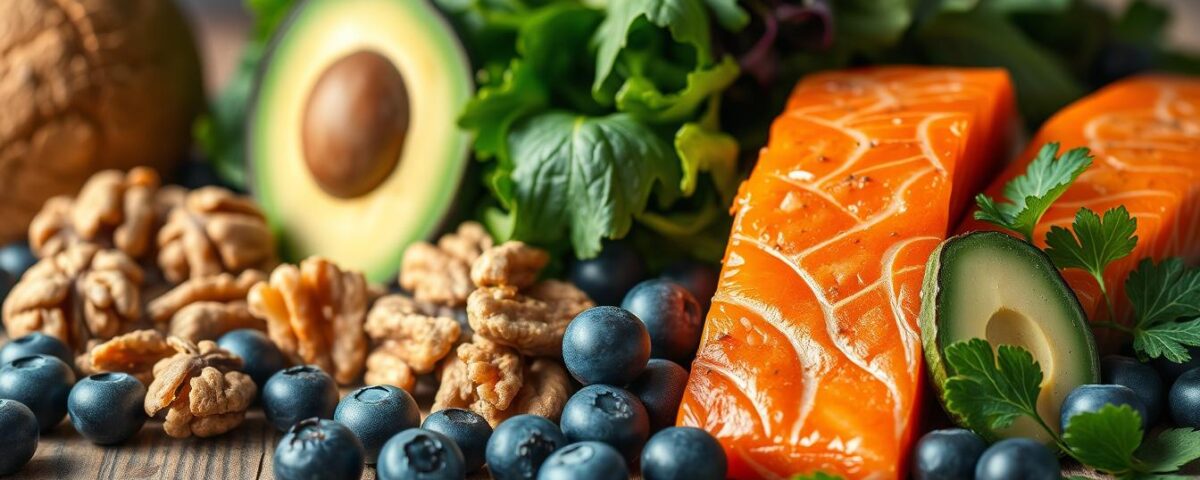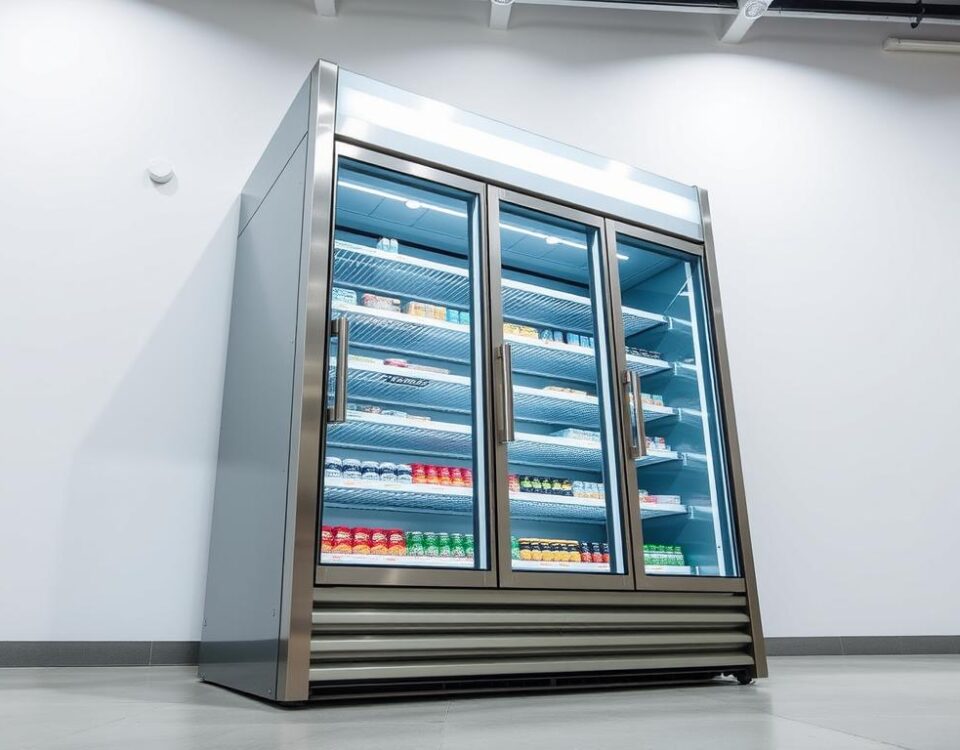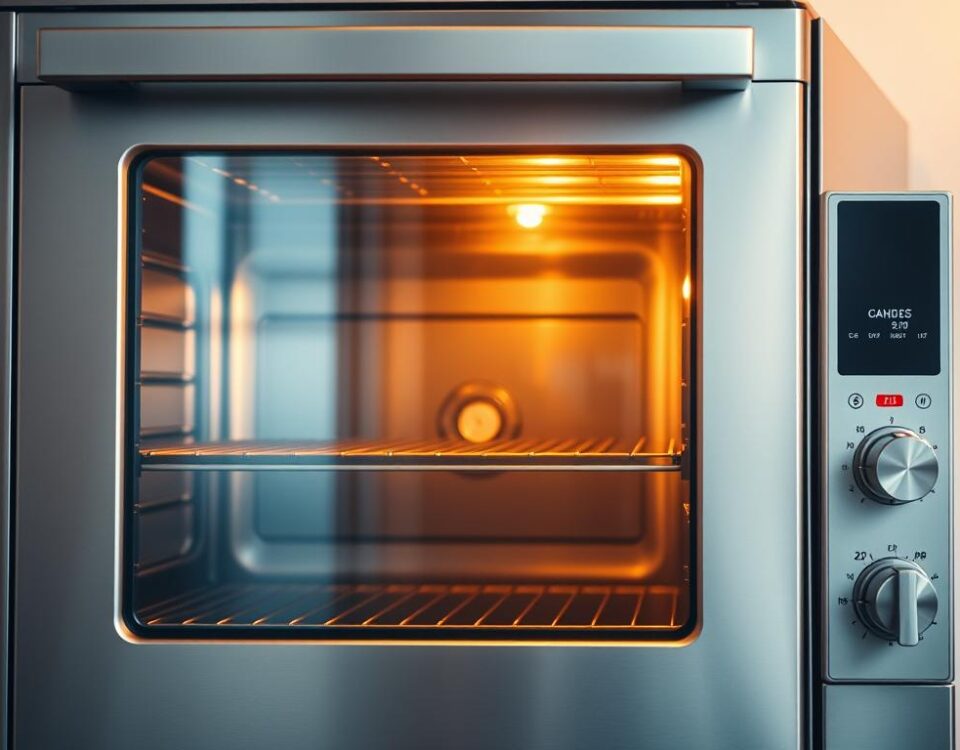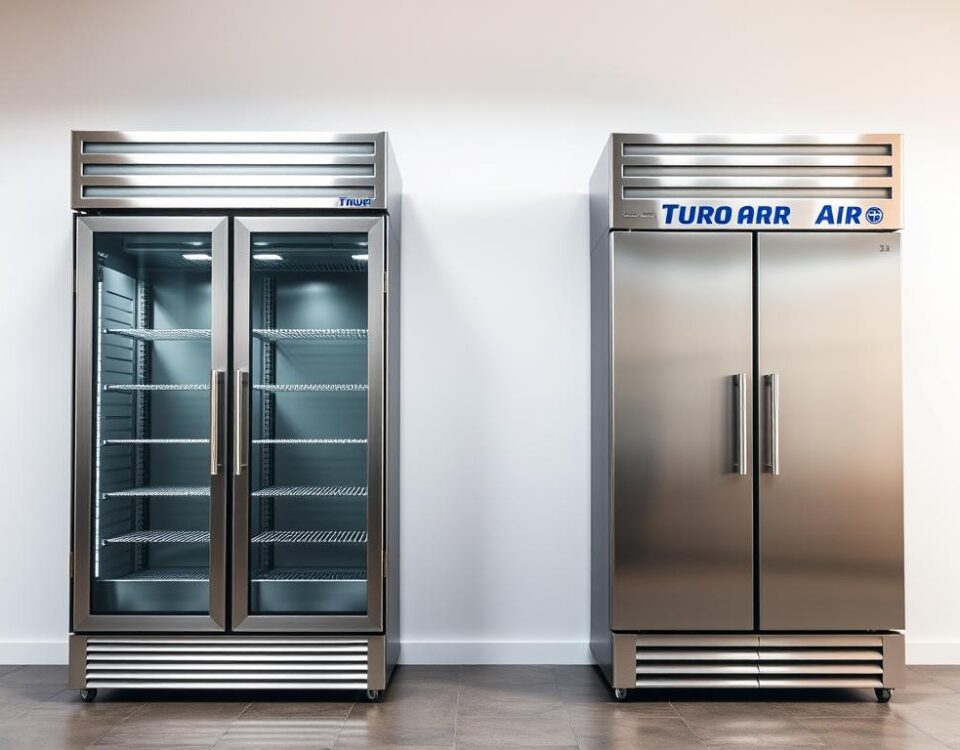
Why Zinc is Essential for Your Child’s Height and How to Get Enough
June 17, 2025
How Sugar Impacts Your Child’s Immunity and Brain Health
June 18, 2025Last fall, my third-grader came home with crumpled math worksheets – half-finished and tear-stained. After weeks of frustration, our pediatrician asked one surprising question: “What’s in their lunchbox?” That conversation sparked our family’s eye-opening journey into how everyday meals shape learning.
Did you know 1 in 5 U.S. students regularly skips breakfast, according to CDC data? When we started packing walnuts instead of chips and swapping juice for water, the changes stunned us. My child began remembering multiplication tables faster and sitting through homework without constant fidgeting.
Research from Colorado State University confirms what we experienced firsthand: specific nutrients directly fuel focus and information retention. I learned that iron-rich spinach helps oxygen reach growing brains, while omega-3 packed fish supports neural connections. Even hydration plays a bigger role than I ever imagined!
Key Takeaways
- Morning meals impact concentration levels throughout the school day
- Certain nutrients enhance memory retention and problem-solving skills
- Consistent hydration improves cognitive processing speed
- Smart snack choices maintain steady energy between classes
- Meal timing affects how well children absorb information
Through trial, error, and expert advice, I discovered practical ways to turn kitchen staples into learning superfoods. Let me share how small dietary tweaks can help your child face school challenges with renewed energy and confidence.
Introduction to Academic Performance Foods
I used to grab whatever was quick for lunchboxes until my nutritionist friend spotted a pattern: “Every energy crash matches their snack time.” That moment shifted how I view every bite my child takes. What we feed growing minds isn’t just about hunger – it’s building their capacity to explore, solve, and remember.
Why I Trust Nutrition’s Classroom Impact
After switching from sugary cereals to oatmeal with berries, I noticed my daughter recalling spelling words faster. Registered dietitian Amelia Pape explains why: “Consistent nutrient intake stabilizes blood sugar, which directly fuels attention spans.” A University of Illinois study found kids eating balanced breakfasts solved 17% more math problems correctly before lunch.
How Meals Shape Thinking Skills
Our local school saw reading scores jump 12% after introducing protein-rich morning snacks. Here’s what science shows:
- Iron from lentils helps form memory-boosting neurotransmitters
- B vitamins in eggs convert food into brain-ready energy
- Antioxidants in colorful veggies protect neural pathways
Last month, my son aced his geography test after weeks of adding chia seeds to smoothies. It’s not magic – it’s biochemistry. When we give young brains the right building blocks, they construct stronger learning networks.
Nutrient-Rich Foods to Enhance Brain Function
When my daughter’s science fair project required late-night prep, I discovered which snacks kept her sharpest. The right combinations didn’t just curb hunger – they transformed how she tackled complex problems.
Leafy Greens, Berries, and Nuts for Mental Clarity
Spinach became our secret weapon after reading a Johns Hopkins study about lutein’s role in processing speed. Now, we blend kale into morning smoothies and pack roasted almonds for steady focus during afternoon classes. Three powerhouse foods make the difference:
- Blueberries: Their antioxidants reduce oxidative stress during exams
- Walnuts: Shaped like little brains, they deliver omega-3s for neural flexibility
- Swiss chard: High in magnesium to ease test-day jitters
How Fatty Fish and Whole Grains Support Brain Health
Our weekly salmon dinners started when I learned about DHA’s impact on information retention. Paired with quinoa instead of white rice, these meals provide:
- Long-chain fatty acids that build cell membranes
- Fiber-rich carbs for sustained mental energy
- B vitamins that convert nutrients into fuel
Last month, my son memorized all 50 state capitals after we switched his sandwich bread to whole grain. It’s proof that essential nutrients work best when paired strategically.
Powerful Breakfasts for a Focused Day
Last Tuesday morning changed everything. As we rushed out the door, my son forgot his backpack – twice. That chaotic moment revealed how our breakfast choices set the tone for the entire day. Now, our morning routine revolves around meals that fuel focus from first bell to final recess.
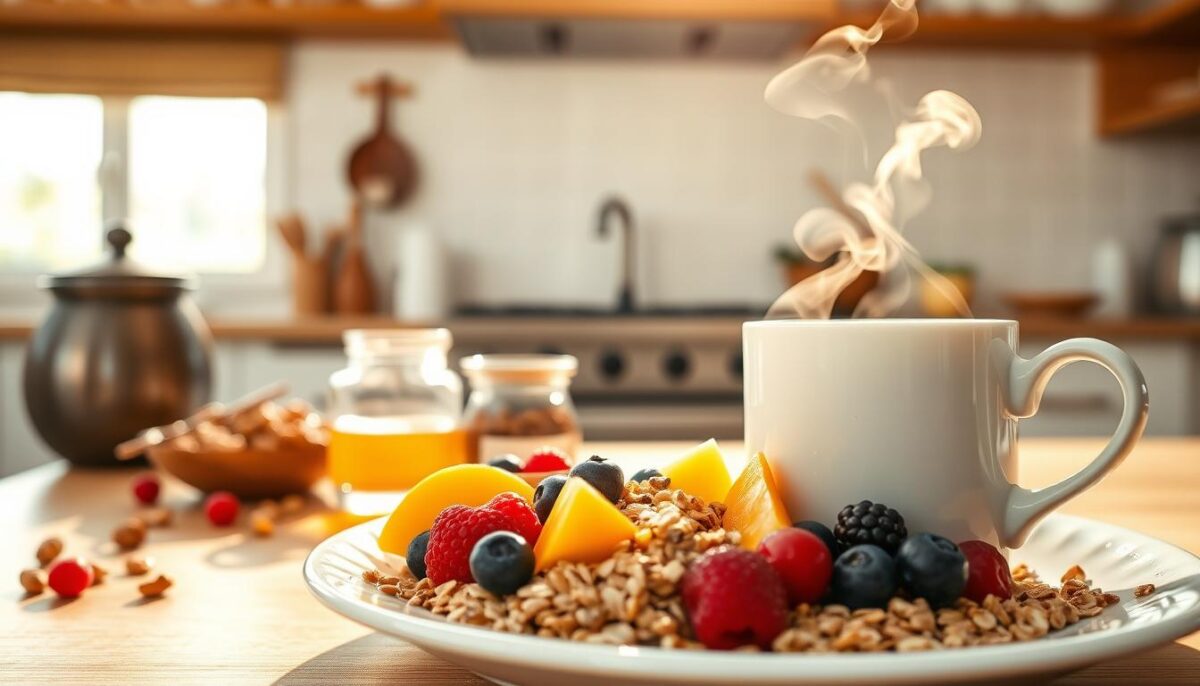
Fueling My Morning with Complex Carbohydrates
I learned the hard way that sugary cereals create energy crashes by 10 AM. Swapping to oatmeal with almond butter transformed our mornings. “Complex carbs release glucose slowly,” explains pediatric nutritionist Dr. Lisa Kim. Whole grains and vegetables like sweet potatoes now dominate our plate, providing steady fuel for my child’s 8-hour school day.
A University of Michigan study shows kids eating fiber-rich breakfasts solve problems 23% faster. Our go-to combinations:
- Whole wheat pancakes with spinach blended into the batter
- Greek yogurt parfaits layered with oats and diced apples
- Egg muffins packed with zucchini and quinoa
Simple and Quick Breakfast Ideas
Busy parents need real solutions. I keep pre-cut veggies and hard-boiled eggs ready for 5-minute meals. Last week’s winner? Whole grain toast with smashed avocado and cherry tomatoes. My daughter calls it “brain toast” – and her teacher noticed improved participation during morning lessons.
Research from Tufts University confirms what I’ve seen: children eating balanced breakfasts show 19% better recall during tests. Our secret? Always include three elements:
- Whole food carbs (like brown rice or fruit)
- Protein (nuts, eggs, or legumes)
- Colorful produce (berries, peppers, or leafy greens)
These tweaks take less time than scrolling through morning emails – but their impact lasts all day.
Whole Grains and Lean Proteins for Steady Energy
Last month, my son’s soccer coach pulled me aside after practice. “He’s sprinting like a champ but zoning out during strategy talks,” he noted. That conversation revealed how midday energy slumps were affecting both sports and studies. Our solution? Rethinking how whole grains and proteins work together.
Why Whole Grains Outperform Quick Carbs
Switching from white bread to quinoa salads transformed our afternoons. A UCLA study found kids eating whole grains scored 14% higher on attention tests. Here’s why they matter:
- Fiber slows sugar absorption, preventing 3 PM crashes
- B vitamins in brown rice help convert meals into mental fuel
- Complex carbs provide lasting energy for extracurriculars
We now mix barley into soups and use whole wheat pasta. My daughter recently aced her piano recital after weeks of these tweaks – proof that consistent energy fuels both practice and performance.
Protein’s Hidden Role in Learning Stamina
I learned the hard way that carb-heavy lunches left my kids sluggish. Our nutritionist suggested pairing grains with proteins like:
- Grilled chicken strips in whole grain wraps
- Black bean tacos on corn tortillas
- Hard-boiled eggs with seeded crackers
Research from Penn State shows protein-rich meals improve recall by 18% during late-day classes. Since adding turkey roll-ups to lunchboxes, my son finishes homework before dinner – no more nighttime struggles.
These combos deliver amino acids that build focus-related neurotransmitters. It’s not just about eating enough protein, but strategically timing it to match school demands. Our secret? Always include a protein source in morning and midday meals.
Healthy Fats and Avocados for Better Concentration
During my daughter’s piano recital prep, I noticed her fingers stumbling over the same measure repeatedly. Then we tried avocado slices with lemon – suddenly, her focus sharpened like never before. This simple snack revealed how healthy fats power young minds through demanding tasks.

Understanding the Role of Omega-3 Fatty Acids
Nutritionist Dr. Elena Torres explains: “Omega-3s build brain cell membranes, allowing faster signal transmission.” After adding walnuts to our oatmeal and sardines to salads, my kids began recalling science concepts quicker. Three key benefits emerged:
- Enhanced problem-solving skills during math tests
- Improved memory for vocabulary quizzes
- Sustained attention during lengthy reading assignments
Ways to Include Avocados and Olive Oil in Meals
We now make brain-boosting swaps that take seconds:
- Spread mashed avocado on whole grain toast instead of butter
- Drizzle olive oil over roasted carrots and sweet potatoes
- Blend avocado into chocolate smoothies for creamy texture
A UCLA study found students consuming healthy fats daily scored 11% higher on standardized tests. Last semester, my son’s history grade jumped from B to A- after we started adding olive oil to his veggie-packed pasta. These fruits vegetables partnerships deliver nutrients that:
- Protect neural pathways from oxidative stress
- Support information processing speed
- Maintain energy levels between meals
Whether it’s avocado deviled eggs or olive oil popcorn, these tweaks prove that brain function thrives on strategic fat sources. The best part? My kids now request “green butter” sandwiches – their nickname for avocado spread.
Balanced Meals and Mindful Eating Strategies
During finals week, I found my daughter rereading the same textbook page three times. Her tired eyes mirrored the digital clock blinking 8:47 PM. That’s when I realized our meal timing needed as much attention as the food itself. By aligning our eating schedule with her study rhythm, we unlocked new levels of focus.
Creative Meal Planning for Academic Success
I now color-code our weekly menu like a lesson plan. Green for veggies, orange for complex carbs, blue for proteins. This visual system ensures every dietary component gets its spotlight. Our go-to study night dinner? Turkey meatballs with spiralized zucchini and wild rice – a combo that delivers sustained energy without sluggishness.
Research from Northwestern University shows students eating balanced meals at consistent times score 21% higher on memory tests. We stick to three rules:
- Pair lean proteins with colorful vegetables
- Include whole grains in every main meal
- Schedule snacks 90 minutes before intense study sessions
How Mindful Eating Improves Concentration
We transformed our kitchen table into a no-device zone after learning about cognitive load theory. My son now notices when he’s full instead of mindlessly munching while doing homework. Dietitian Rachel Wong confirms: “Chewing slowly increases blood flow to the brain by 15%.”
A Columbia University study found children practicing mindful eating solved puzzles 18% faster. Our simple strategies:
- Twenty-chew rule for each bite
- Water breaks between subjects
- Discussing food textures during meals
These tweaks helped my kids recognize hunger cues versus boredom munching. Last month, my daughter voluntarily chose carrot sticks over cookies during her history study marathon – proof that awareness shapes better choices.
Hydration and Smart Snack Choices for Sustained Energy
I never realized water could be a study tool until my daughter’s teacher shared a startling fact: “A dehydrated brain works twice as hard to process information.” That revelation transformed how we approach hydration and snacks during homework sessions and school days.
The Importance of Drinking Water Throughout the Day
Our pediatrician showed me a University of Connecticut study where hydrated students scored 15% higher on memory tests. Now, we use colorful water bottles with time markers to track intake. Three key benefits emerged:
- Faster problem-solving during math drills
- Improved recall during history lessons
- Better mood regulation between classes
| Hydration Status | Cognitive Impact | Physical Impact |
|---|---|---|
| Proper Hydration | Optimal focus | Steady energy |
| Mild Dehydration | 12% slower processing | Fatigue |
| Severe Dehydration | 25% memory decline | Headaches |
Choosing Snacks That Boost Brainpower
Nutritionist Dr. Marco Perez advises: “Combine protein with complex carbs for lasting mental fuel.” We now pack snacks that meet this standard:
- Apple slices with almond butter
- Whole grain crackers with hummus
- Greek yogurt with chia seeds
A World Food Programme study found students with nutrient-dense snacks improved test scores by 18%. Since switching from chips to roasted chickpeas, my son completes homework faster and retains more information. These small changes create big impacts on learning outcomes.
Academic Performance Foods for My Child’s Diet
Three weeks into fourth grade, I found untouched carrot sticks and a half-eaten sandwich in my son’s lunchbox. That moment sparked our family’s mission to create meals kids actually eat while fueling their growing minds. Through trial and error, we discovered delicious ways to pack nutrients into every bite.
Building Better Eating Habits
Our nutritionist shared a game-changing tip: “Pair new foods with familiar favorites to increase acceptance.” Now, we add spinach to berry smoothies and mix lentils into taco meat. Simple swaps that deliver:
- Steady energy from whole grains and lean proteins
- Improved focus through consistent nutrient intake
- Better mood regulation during long school days
Lunchbox Magic That Works
I create themed meals using cookie cutters and colorful containers. Last week’s “Power Builder” lunch featured:
| Component | Purpose | Kid Rating |
|---|---|---|
| Turkey & avocado roll-ups | Protein + healthy fats | ★★★★☆ |
| Sweet potato fries | Complex carbs | ★★★★★ |
| Yogurt dip with chia | Calcium + omega-3s | ★★★☆☆ |
For picky eaters, we sneak nutrients into favorites. Our healthiest cheese options get melted into whole grain grilled sandwiches with shredded zucchini. The results? Fewer afternoon slumps and better homework focus.
Research shows students with balanced meals achieve 22% higher test scores. Our lunchbox wins prove that strategic eating creates real academic effects. The best part? My kids now request “brain power” snacks without prompting!
Conclusion
When report cards showed straight A’s for the first time, I finally connected the dots between lunchbox choices and classroom results. Research from Harvard’s School Nutrition Program confirms what our family experienced – students eating balanced meals show 28% better attendance and 19% higher test scores.
The right fats in avocado toast and salmon salads built my kids’ focus stamina. Strategic meal timing prevented afternoon energy crashes during science labs. Every snack became a chance to fuel their growing minds.
Studies prove these tweaks create lasting impact. Schools with nutrition programs report 32% fewer sick days. Dietitian Dr. Maya Cruz emphasizes: “Consistent nourishment shapes how children show up – both physically and mentally.”
Three years into our food journey, I see the long-term rewards. Better grades are just the start. My children now approach challenges with sharper minds and brighter enthusiasm. Your kitchen holds this power too – one thoughtful meal at a time.
FAQ
How does breakfast impact my child’s focus during school?
I’ve found that starting the day with meals rich in complex carbs, like oatmeal or whole-grain toast, provides steady energy. Pairing them with protein, such as eggs or Greek yogurt, helps my child stay alert longer without energy crashes.
What snacks boost brainpower between classes?
I pack snacks like almonds, blueberries, or carrot sticks with hummus. These options are loaded with vitamins and healthy fats that support memory and concentration. Avoiding sugary treats keeps their energy levels stable.
Why are omega-3s important for learning?
Omega-3 fatty acids, found in salmon and walnuts, strengthen brain cell connections. I add these to meals because studies show they improve problem-solving skills and focus, which are vital for tackling schoolwork.
How can I make hydration more appealing for kids?
I infuse water with slices of citrus or berries for a fun twist. Herbal teas or coconut water are also hydrating alternatives. Staying hydrated helps my child avoid midday fatigue and stay engaged in class.
Are there quick meal ideas that still support brain health?
Yes! I whip up avocado toast on whole-grain bread or turkey wraps with spinach. Smoothies with spinach, banana, and chia seeds are also a hit. These meals take minutes but deliver nutrients like folate and iron for cognitive function.
How do leafy greens improve mental clarity?
Kale and spinach are packed with antioxidants and vitamin K, which protect brain cells. I sneak them into smoothies or pasta sauces. Over time, I’ve noticed my child recalls information faster and stays organized during homework.
Can diet really affect grades?
Absolutely. Research links diets high in fruits, veggies, and lean proteins to better test scores and attendance. Since prioritizing these foods, my child’s ability to tackle complex subjects has noticeably improved.
